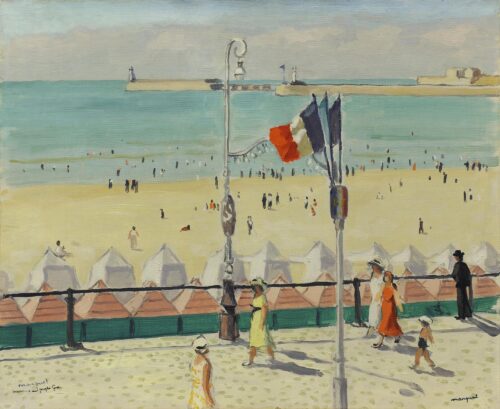
Marquet Albert (1875 - 1947)
Seaside, before 1947
He commenced his studies at the age of fifteen at the Ecole des Artes Decoratifs where he met Matisse, and they remained friends to the end of his life, continuing their studies together at the Ecole des Beaux Arts in the Gustave Moreau studio. After his teacher’s death he left the Ecole des Beaux Arts and, again with Matisse, continued at a free academy. Together with Camoin they painted street scenes.
He held his first solo exhibition in 1907.
Though he exhibited at the Salon d’ Automne in 1905, in the Fauvist room, his color was never as intense or as luminous as the others. Nevertheless, the bonds of friendship that linked him with three of the most important artists of this style (Matisse, Dufy and Manguin) made him a courageous defender of the movement, which had provoked a strong reaction in the beginning. The traditional scope of his work is much more apparent than in the others and though his color is at times strong it is never arbitrary. Like Dufy he chose subjects that were characterized by their intense colors.
During the early years his color was placed lavishly on the canvas and the brushstroke was conspicuous, while later his works became smooth and finely executed.
The largest part of his work was exclusively involved with the French landscape. From 1920 on he made regular trips to Algeria in order to continue to paint outdoors. This date also marks the beginning of his long period of wanderlust, though he would return each year to Paris and Algeria for considerable lengths of time. He travelled to Tunisia, Norway, Egypt, Spain, Rumania, the Soviet Union, Morocco, Italy, Switzerland, the Netherlands, and Sweden.
He was inspired by all the countries he visited to paint landscapes that exuded feelings of measure and harmony. The particular light of each landscape and the coloring the landscape acquires because of it, can be clearly seen in each of his works.
He was also a friend of the writer Charles Louis Philippe.

Seaside, before 1947

We use cookies to make our site work properly, to personalize content and ads, to provide social media features and to analyze our traffic. We also share information about how you use our site with our social media, advertising and analytics partners. Read the Cookies Policy.
These cookies are necessary for the website to function and cannot be switched off in our systems. They are usually only set in response to actions made by you which amount to a request for services, such as setting your privacy preferences, logging in or filling in forms. You can set your browser to block or alert you about these cookies, but some parts of the site will not then work. These cookies do not store any personally identifiable information.
If you disable this cookie, we will not be able to save your preferences. This means that every time you visit this website you will need to enable or disable cookies again.
These cookies tell us about how you use the site and they help us to make it better. For example these cookies count the number of visitors to our website and see how visitors move around when they are using it. This helps us to improve the way our site works, for example, by ensuring that users find what they are looking for easily. Our website uses Google Analytics for statistics reporting.
Please enable Strictly Necessary Cookies first so that we can save your preferences!